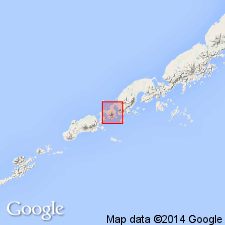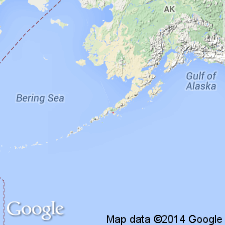
- Usage in publication:
-
- Tachilni formation*
- Modifications:
-
- Named
- Dominant lithology:
-
- Sandstone
- Graywacke
- Conglomerate
- AAPG geologic province:
-
- Alaska Peninsula province
- Alaska Southwestern region
Summary:
Type locality designated as exposures near Cape Tachilni, Frosty Peak area between Cold Bay on east and Morzhovoi Bay on west, Alaska Peninsula, AK. Crops out discontinuously along Pacific coast from west side of Thinpoint Cove to as far west as Cape Tachilni. Is sequence of poorly consolidated predominantly sedimentary rocks, sandstone, graywacke, grit and pebble conglomerate with some black shale. Is 200 ft thick at type where beds (rich in fossils) dip northward and are unconformably overlain by lava flows. Presumably overlying rocks are part of Morzhovoi volcanics (new). Base of formation not seen. Age is tentatively assigned to late Tertiary. (Collection of fossils were lost.)
Source: GNU records (USGS DDS-6; Menlo GNULEX).

- Usage in publication:
-
- Tachilni Formation*
- Modifications:
-
- Age modified
- Biostratigraphic dating
- AAPG geologic province:
-
- Alaska Peninsula province
- Alaska Southwestern region
Summary:
Age of Tachilni Formation is late Miocene based on age of gastropod, BERINGIUS HERTLEINI MacNeil (Allison, 1978 p.176) which occurs in unit.
Source: GNU records (USGS DDS-6; Menlo GNULEX).
For more information, please contact Nancy Stamm, Geologic Names Committee Secretary.
Asterisk (*) indicates published by U.S. Geological Survey authors.
"No current usage" (†) implies that a name has been abandoned or has fallen into disuse. Former usage and, if known, replacement name given in parentheses ( ).
Slash (/) indicates name conflicts with nomenclatural guidelines (CSN, 1933; ACSN, 1961, 1970; NACSN, 1983, 2005, 2021). May be explained within brackets ([ ]).

